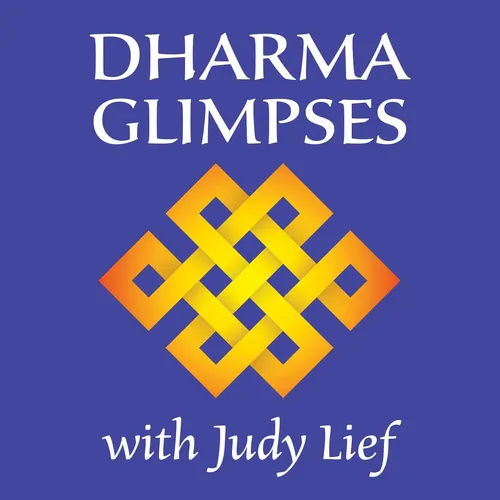
Dharma Glimpses with Judy Lief
DHARMA GLIMPSES is an introduction to The Profound Treasury teachings of Chögyam Trungpa Rinpoche, taught by Judy Lief. In these short, accessible talks, Judy invites listeners to explore the subtleties and delights of the Buddhist path of meditation and insight. She introduces listeners to some of the key ways that mark Chögyam Trungpa Rinpoche's unique and brilliant exposition of the dharma in the context of contemporary Western society.
- Update frequency
- every 7 days
- Average duration
- 7 minutes
- Episodes
- 241
- Years Active
- 2020 - 2025

Episode 41: Three Bowls
In Buddhism there is a lot of discussion about fixed views, which are traditionally described as a pairing of fixation (being stuck in our own particular approach) and grasping (trying to build up ou…

Episode 40: Atmosphere of Discipline
Discipline is what grounds meditation and study and connects them with our activities in the world • the Buddha said discipline should be like tuning a stringed instrument: if you wind a string too…

Episode 39: The River of Love and Compassion
Loving kindness and compassion are two strong currents that run through the entire Buddhist path • they are directly intertwined with the two sides of meditation practice: shamatha, or taming the m…

Episode 38: Awareness, Kindness, Openness
According to the Buddha, all sentient beings have buddhanature or bodhichitta • Trungpa Rinpoche spoke in terms of having “enlightened genes” — we have the DNA of buddhanature within us • our nat…

Episode 37: Meditation and Buddhanature
Meditation is based on the understanding that the deepest nature of human beings—buddhanature—is the capacity to grow and flourish and awaken, to express kindness and generosity and compassion • me…

Episode 36: Situations and Choices
The teachings of karma are vast and profound, and they are central to the message of the Buddha • the term “karma” is often oversimplified, dumbed down, and intermingled with notions of blame and r…

Episode 35: Spirit of Dharma
The spirit of dharma is more about the process of investigating than it is coming up with the right answers • it’s based on a sense of genuine interest and curiosity about the situation we are in, …

Episode 34: A Gentle Interruption of Samsara
What is meditation’s role in finding nirvana within samsara? • samsara moves very quickly; confusion arises instantaneously, exploding and expanding so rapidly that we are overwhelmed • sitting …

Episode 33: Six Samsaric Realms
Today’s topic is about how our moment-to-moment habits and impulses congeal into solid psychological realities or realms of existence • the wheel of life depicts six such realms—gods, jealous gods,…

Episode 32: Enabling Samsara Step by Step
Another section of the wheel of life breaks things down into twelve steps, which illustrate how we perpetuate samsara • the first step is ignorance, which is represented by the image of a blind gra…

Episode 31: Rooster, Snake, Pig
A traditional image in Tibetan Buddhism is called the wheel of life; it pictures our life as a wheel that rolls along, and that we keep pushing along • the wheel of life is held within the jaws of a …

Episode 30: The Dance of Samsara and Nirvana
Samsara and nirvana are two fundamental concepts that run throughout the Buddhist tradition • Trungpa Rinpoche said it is by discovering the truth of samsara that we discover nirvana • samsara re…

Episode 29: Walking Meditation
According to the Buddha, there are four main postures for meditation: sitting, walking, standing, and reclining • walking meditation is often a part of group meditation practice, where there is alt…

Episode 28: Assumptions and Reality
The universal experiences of birth, sickness, old age, and death can serve as our teachers, interrupting assumptions that are not helpful in our journey • they can open our eyes to the ways in whic…

Episode 27: The Balanced Mind
On the surface, meditation is so simple, but somehow through that simplicity a lot of learning happens • we notice how our minds work, how we operate • it’s like inviting a mirror to help us see …

Episode 26: Sculpting a Buddha
The buddhist tradition and training is not about adding anything; it’s about removing, or taking away • removing confusion, selfishness, conflicting emotions, ego fixation, ego absorption • when …

Episode 25: Ego - the Subtle Colonizer
The human mind is unique in that it can observe itself • many buddhist teachings, including the teachings on ego, come from simply looking directly at the mind and taking an interest in what arises…

Episode 24: Deconstructing Ego
Ego isn’t so much a “thing” as it is a project — one that we’re very invested in, and one that is under constant threat • the ego is a construct or overlay, which is not that useful • however, be…

Episode 23: Me, Myself, and I
The idea of “ego” in buddhadharma is different from the notion of having a healthy ego boundary, which is often associated with a sense of self-confidence, resilience, and inner strength • in Buddh…

Episode 22: Sun and Clouds
The assumptions we make about human nature are an essential part of the Buddhist path • the view of Buddhism is the opposite of the view of "original sin"; it is the view of original purity, of ori…